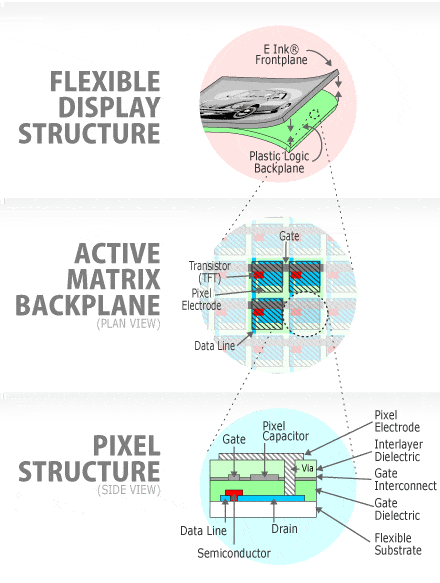
After a decade of development and the invention of some truly groundbreaking technology, flexible plastic display screens are still having a bit of a hard time finding their niche. The trouble is that the potential for this type of technology is astonishing, including everything from space-race tech for the next mission to Mars through to flexible watches and wraparound screens for the next generation of iPods. So it’s difficult to narrow down exactly where flexible plastic display screens fit into the grand scheme of things, and without a clearly defined direction, the technology could be simply treading water while it waits for an opportunity.
However, those involved in the cutting edge of flexible screen technology aren’t just thinking small – they’re thinking big too. Plastic Logic, one of the leading exponents of flexible plastic screen displays, have recently teamed up with Japanese giants TOPPAN Printing to develop a new, 42-inch flexible plastic screen that is specifically designed for use as a poster and in larger displays.
While a screen that’s just over a meter square may not be the largest of advertising hoardings, it does represent a new direction for the application of flexible plastic screens, and one that has been discussed for some time. The prototype has been showcased in Japan, and as to be expected in a country that adores new gadgets, it’s been greeted with considerable excitement.
Multi-Cell Technology
However, this large flexible plastic display screen isn’t quite what it first appears to be. It’s actually 16 cells of just under 11 inches square that have been tiled together. The result is a large surface area display that is a mere 3mm thick and has a pixel pitch of 0.7 mm.
And it’s the resolution that is really starting peak the interest of advertising specialists in particular, as it represents a huge improvement on existing EPD signage. What that means in plain English is that even close up, the resolution of these new plastic display screens is far better quality and much less pixellated than LED signs, for example.
Minimum Power Usage
Another plus point for the new technology is how much power it uses – which is minimal. The bi-stability of the display means that a static image is maintained even when there is no power being supplied to the system, and it only actually requires a minimum amount of power input when the image is changed.
The use of e-ink means that the displays are reflective (in the same way that paper is) and can be read in any type of lighting condition, including low-level or bright sunlight. This has been a stumbling block for electronic displays for some time, as many perform poorly when used in bright sunlight. The signs can also be read from just about any angle, making them ideal for both indoor and outdoor applications.
The collaboration with TOPPAN Printing could be a major step forward for Plastic Logic’s technology, as it represents a very high profile application that will showcase the numerous advantages of the technology. While there are plenty of other applications that the technology can be put towards, it is in advertising signage that the public is likely to first encounter what promises to be a revolutionary new direction in flexible electronics. With this, and the potential applications in gadgets such as e-readers, smartphones and even wearable devices, it looks like Plastic Logic’s flexible screens are finally finding their place in the world.
Looks like an innovative billboard idea.